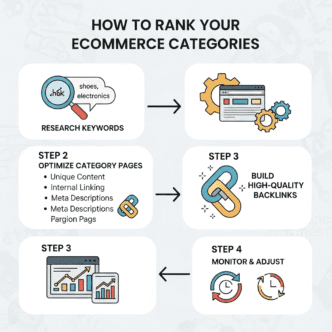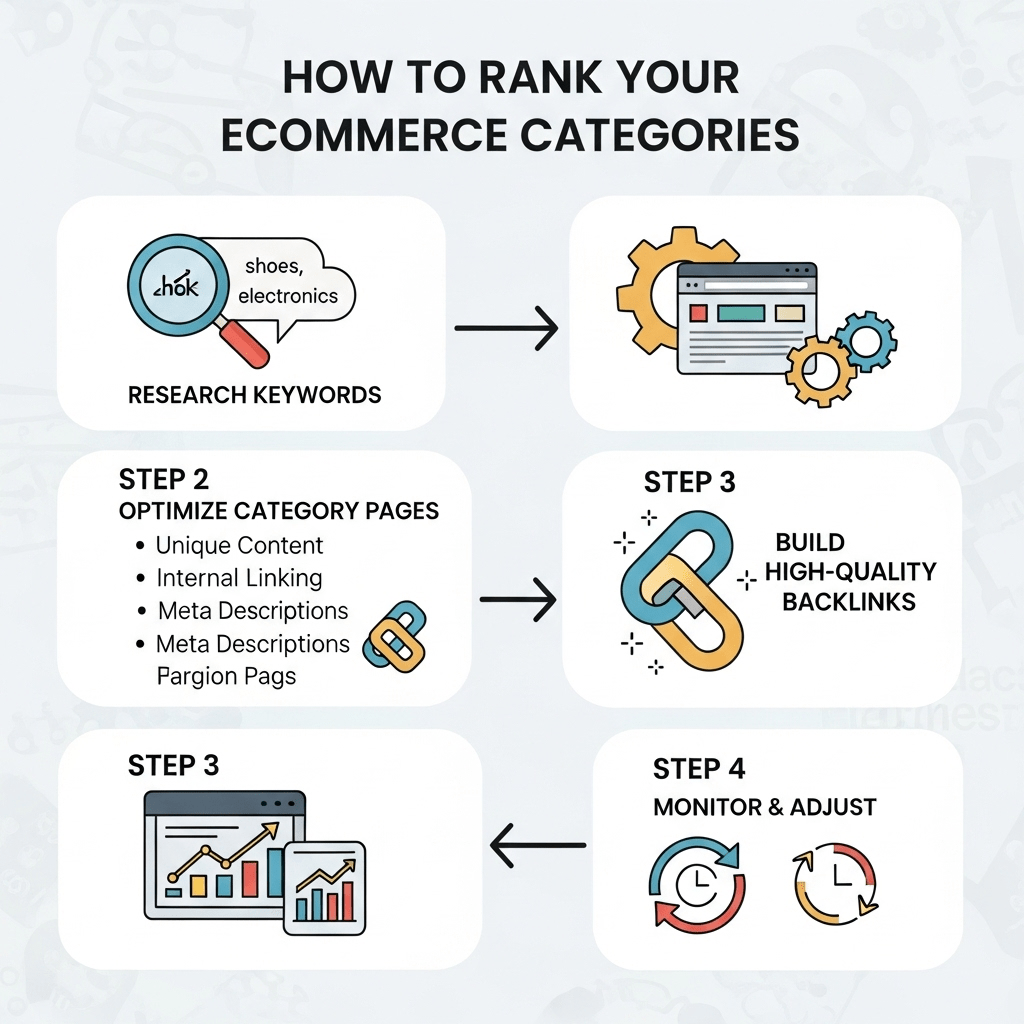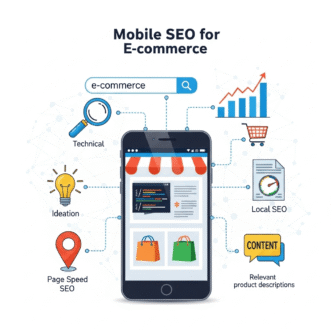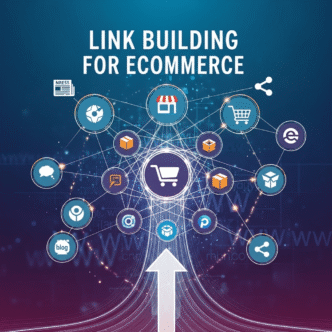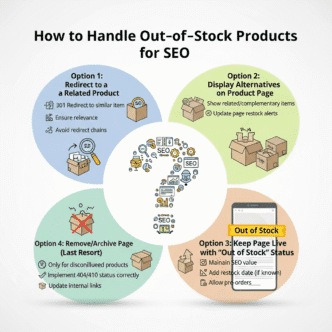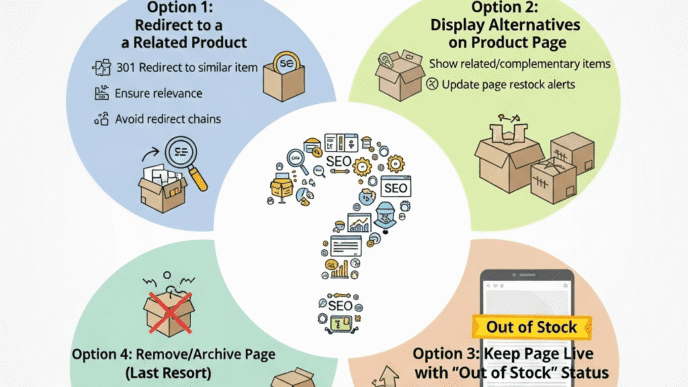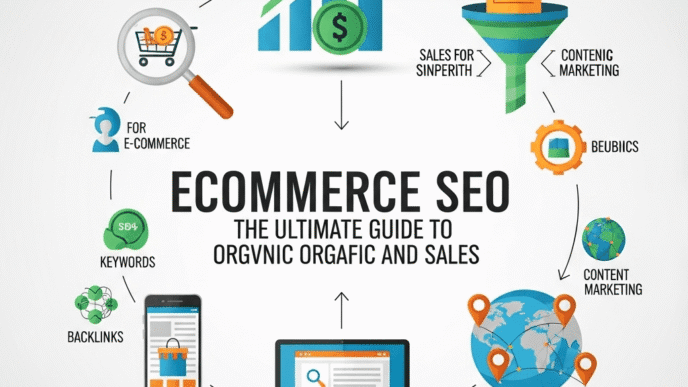Your product pages are optimized. Your blog content is solid. But somehow, your competitors are dominating search results for broad terms like “men’s running shoes” and “organic coffee beans” while you’re stuck on page five.
The secret? They’ve mastered category page SEO—the art of ranking collection pages that capture high-volume, high-intent search traffic. While most store owners obsess over individual product pages, smart ecommerce brands understand that category pages are the real traffic goldmines.
This guide will show you exactly how to optimize category pages for SEO so you can rank on page one for those juicy category keywords that bring in ready-to-buy customers. Let’s turn those underperforming category pages into conversion machines.
Table of Contents
ToggleWhy Category Page SEO Matters More Than You Think
Here’s something most store owners don’t realize: someone searching “running shoes” isn’t ready to buy a specific product yet. They’re browsing, comparing, exploring options. Your category page is perfect for capturing this traffic.
According to Ahrefs data, category-level keywords typically have 10-50x more search volume than specific product keywords. “Yoga mats” gets 74,000 monthly searches. “Manduka PRO yoga mat black” gets 320. See the difference?
Category pages serve multiple purposes:
- Capture high-volume category keywords
- Showcase your product range
- Guide customers toward specific products
- Build topical authority in your niche
- Rank for commercial intent searches
The problem? Most category pages are SEO disasters—thin content, no unique value, just a grid of products with a generic two-sentence description. Google can’t rank what doesn’t deserve to rank.
Pro Tip: According to a study by Backlinko, the average first-page result contains 1,447 words of content. Yet most category pages have under 100 words. This is your opportunity—add substantial, helpful content and watch your rankings climb.
For the complete foundation of ecommerce SEO strategy, check our ultimate ecommerce SEO guide.
What Makes a Category Page Rank on Page One?
Before diving into tactics, let’s understand what Google actually wants from ecommerce category optimization.
The Three Pillars of Category Page Rankings
1. Substantial, Unique Content Google needs enough text to understand what you’re selling and why your page deserves to rank. Thin content doesn’t cut it anymore.
2. Clear Topical Relevance Your category page must clearly demonstrate expertise in that product category through comprehensive information, not just product listings.
3. Strong User Experience Signals Low bounce rates, good time-on-page, and high engagement tell Google your page satisfies searcher intent.
Think of your category page as a mini-guide that helps customers understand the category, choose the right product, and make confident buying decisions. That’s what ranks.
How to Optimize Category Pages for SEO: The Complete Strategy
Let’s break down category page SEO best practices into actionable steps you can implement today.
1. Keyword Research for Category Pages
Not all category keywords are created equal. You need to target terms you can actually rank for.
Target keyword patterns:
- Product category plurals: “running shoes,” “coffee makers,” “yoga mats”
- “Best” variations: “best espresso machines,” “best standing desks”
- Use case keywords: “hiking boots for wide feet,” “laptops for video editing”
- Brand + category: “Nike running shoes,” “Vitamix blenders”
Keyword difficulty reality check:
| Keyword Type | Competition | Volume | Realistic for New Store? |
|---|---|---|---|
| “shoes” | Impossible | 500K+ | No |
| “running shoes” | Very High | 74K | Unlikely |
| “trail running shoes” | High | 12K | Maybe |
| “minimalist running shoes” | Medium | 2.4K | Yes |
| “barefoot running shoes women” | Low | 480 | Yes |
Pro Tip: Use Google Keyword Planner or Ahrefs to find category keywords with decent volume (1,000+ monthly searches) and manageable difficulty for your domain authority. Don’t try to compete with Amazon for “shoes”—target specific subcategories where you can actually win.
2. Writing Category Descriptions for SEO That Actually Rank
This is where most stores fail. A 50-word generic description won’t rank. Period.
The winning formula:
Minimum 300 words (aim for 500-800 for competitive categories) Above the product grid (at least a compelling first paragraph) Below the products (expand with additional helpful content)
What to include in category page content:
Opening paragraph (above products):
- Primary keyword naturally integrated
- Clear value proposition
- Brief category overview
- Compelling reason to keep reading
Expanded content (below products):
- Buying guide tips (“How to choose the right…”)
- Common questions answered
- Product comparisons and use cases
- Size guides or specifications
- Care instructions or usage tips
Content structure example for “Organic Baby Clothes” category:
[Opening - 100 words above products]
"Discover our curated collection of organic baby clothes made from 100% certified organic cotton. Every piece is GOTS certified, free from harmful chemicals, and gentle on your baby's sensitive skin. From newborn essentials to toddler favorites, our sustainable baby clothing combines safety, comfort, and style."
[Product Grid]
[Expanded content - 400-600 words below products]
H3: Why Choose Organic Baby Clothes?
H3: How to Select the Right Size
H3: Caring for Your Organic Baby Clothing
H3: Our Organic Certification Standards
Pro Tip: Study your top 3 competitors ranking for your target keyword. What content are they providing? Don’t copy—create something better, more comprehensive, and more helpful. Google rewards the most useful resource, not the first one.
Real-world example: A children’s clothing store rewrote their “Baby Sleepwear” category page from 75 words to 650 words, adding buying tips, fabric comparisons, and safety guidelines. Rankings improved from position 47 to position 8 within 12 weeks, increasing organic traffic to that category by 340%.
3. Optimize Category Page Titles and Meta Descriptions
Your title tag and meta description are your first impression in search results. Make them count.
Title tag formula:
[Primary Keyword] | [Value Proposition] | [Brand Name]
Examples:
- ❌ Bad: “Running Shoes – Shop Now”
- ✅ Good: “Running Shoes for Men & Women | Free Shipping | [Brand]”
- ✅ Better: “Best Trail Running Shoes 2025 | Waterproof & Lightweight | [Brand]”
Title tag rules:
- 50-60 characters (to avoid truncation)
- Primary keyword near the beginning
- Include compelling modifiers (free shipping, best, 2025)
- Brand name at the end (optional if space limited)
Meta description formula:
[What you sell] + [Unique benefit] + [Social proof/offer] + [Call to action]
Example: “Shop our collection of organic baby clothes made from 100% GOTS-certified cotton. Trusted by 50,000+ parents. Free shipping over $50. Find the perfect outfit today.”
Meta description rules:
- 150-160 characters optimal
- Include primary keyword naturally
- Emphasize unique value props
- Strong call-to-action
- Use special characters (✓, •, →) sparingly for emphasis
Pro Tip: Test your titles and descriptions in Moz’s SERP Preview Tool to see exactly how they’ll appear in search results. What looks good in your CMS might get cut off in actual search results.
4. Strategic Internal Linking for Category Pages
Internal linking for category pages distributes authority and helps Google understand your site structure.
Link TO category pages from:
- Homepage (main navigation, featured categories)
- Other category pages (related categories sidebar)
- Blog posts (contextual links to relevant categories)
- Product pages (breadcrumbs, “shop all [category]” links)
Link FROM category pages to:
- Subcategories (if you have them)
- Featured or bestselling products
- Buying guide blog posts
- Related categories
- Size guides or resource pages
Anchor text strategy:
- Use descriptive, keyword-rich anchors
- Vary your anchor text naturally
- Avoid generic “click here” or “learn more”
- Include category keywords in anchors
Example internal linking:
Homepage → "Shop Men's Running Shoes" (navigation)
Blog post → "best trail running shoes" (contextual)
Product page → "Running Shoes" (breadcrumb)
Related category → "trail running shoes" (sidebar)
Pro Tip: Create a “hub and spoke” model where each main category acts as a hub linking to related subcategories and products. This structure helps Google understand topical relationships and distributes link equity effectively throughout your site.
Learn more about building powerful internal linking structures in our ecommerce SEO guide.
How to Structure Category Pages for Maximum SEO Impact
Ecommerce category optimization requires thoughtful page structure that serves both users and search engines.
Above the Fold Elements
What users should see immediately:
- Clear category name (H1 tag with primary keyword)
- Brief, compelling description (100-150 words)
- Trust signals (reviews, certifications, guarantees)
- Filter/sort options (for easy browsing)
- Featured products or bestsellers
H1 tag best practices:
- Include primary keyword naturally
- Keep it under 70 characters
- Match user search intent
- Avoid keyword stuffing
Examples:
- ❌ Bad: “Products | Category | Shop”
- ✅ Good: “Men’s Running Shoes”
- ✅ Better: “Men’s Running Shoes | Trail & Road Running”
Content Placement Strategy
Option 1: Content Above Products (Recommended for new categories)
- Helps with initial indexing
- Ensures Google sees content immediately
- May push products below the fold
Option 2: Content Below Products (Works for established categories)
- Products visible immediately
- Better initial user experience
- Google still crawls and values the content
Option 3: Hybrid Approach (Best of both worlds)
- 100-150 word intro above products
- Detailed content (400-600 words) below products
- Expandable “Read more” for cleaner design
Pro Tip: Test both placements with A/B testing. Monitor bounce rates and time-on-page. Some categories perform better with content above, others below. Data beats opinions every time. I’ve found that newer stores benefit from content above products while established brands can place it below.
Product Display Optimization
SEO-friendly product grid elements:
- Clean product URLs visible in HTML
- Descriptive product image alt text
- Quick-view doesn’t block crawling
- Load more pagination (not infinite scroll)
- Structured data for each product
Pagination handling:
<link rel="canonical" href="https://yourstore.com/running-shoes/" />
For page 2, 3, etc., either:
- Canonical to page 1 (preferred)
- Self-referencing canonical
- View all option (if feasible)
Avoid infinite scroll—it makes it harder for Google to discover all products. Use “Load More” or traditional pagination instead.
What Role Do Filters and Faceted Navigation Play in Category Page SEO?
Filters are essential for user experience but create duplicate content nightmares if not handled properly.
The Duplicate Content Problem
Every filter combination creates a unique URL:
/running-shoes/
/running-shoes/?color=blue
/running-shoes/?color=blue&size=10
/running-shoes/?color=blue&size=10&brand=nike
/running-shoes/?sort=price
Suddenly you have hundreds or thousands of near-identical pages competing with each other.
Solutions for Filter URLs
Strategy comparison:
| Approach | When to Use | Pros | Cons |
|---|---|---|---|
| Canonical to main category | Most filters | Clean, simple, prevents duplication | Loses potential long-tail rankings |
| Noindex filtered pages | Low-value filters | Saves crawl budget | Completely removes from index |
| Index strategic filters | Brand/material filters | Captures valuable long-tail keywords | Requires unique content for each |
| Parameter handling | All approaches | Tells Google how to handle filters | Requires Search Console setup |
Pro Tip: Index valuable filters that people specifically search for (like brand names: “Nike running shoes”) but canonical or noindex random combinations. Use Google Search Console URL Parameters to tell Google which parameters to ignore and which represent different content.
Creating SEO-Friendly Filter Pages
If you decide to index certain filtered pages, treat them like mini-category pages:
Requirements for indexed filter pages:
- Unique H1 tag (“Nike Running Shoes” not “Running Shoes”)
- Unique meta title and description
- 200-300 words of unique content
- Proper canonical tag structure
- Clear value to users
Don’t index filters unless you’re willing to create unique content for them. Half-hearted indexed filters hurt more than they help.
How to Leverage Schema Markup for Category Pages
Structured data helps Google understand and display your category pages with rich snippets.
Essential Schema Types for Categories
1. Breadcrumb Schema: Shows navigation path in search results.
2. CollectionPage Schema: Identifies the page as a product collection.
3. ItemList Schema: Lists products within the category.
Combined schema example structure:
{
"@context": "https://schema.org",
"@type": "CollectionPage",
"name": "Men's Running Shoes",
"description": "Discover our collection of running shoes...",
"url": "https://yourstore.com/running-shoes/",
"breadcrumb": {
"@type": "BreadcrumbList",
"itemListElement": [...]
}
}
Pro Tip: Use Google’s Rich Results Test to validate your schema implementation. Most ecommerce platforms have apps or plugins that add schema automatically—verify they’re working correctly rather than coding from scratch.
What About Category Page Content: How Much Is Enough?
The eternal question: how much category page content do you actually need?
Content Length Guidelines
Minimum viable: 300 words Competitive: 500-800 words Highly competitive: 1,000-1,500 words
But length alone doesn’t win. Quality and relevance matter more.
What “enough” content actually means:
- Answers common category questions
- Helps customers make decisions
- Provides value beyond product listings
- Covers topic comprehensively
- Includes natural keyword variations
Content Quality Over Quantity
Good 500-word category content beats:
- Generic 1,500-word AI-generated fluff
- Keyword-stuffed nonsense
- Manufacturer description copies
- Irrelevant information padding
Pro Tip: Analyze the top 5 ranking pages for your target keyword. What content are they providing? What questions are they answering? Create something better and more comprehensive. Don’t just match—exceed.
Real example: A supplement store analyzed top-ranking “protein powder” category pages and found they all included comparison tables, ingredient explanations, and usage guides. They created a 1,200-word guide covering these topics plus allergy information and certification details. Ranking improved from position 32 to position 6 in 10 weeks.
For comprehensive content strategies, explore our ecommerce SEO ultimate guide.
How to Handle Seasonal Category Pages
Seasonal categories (like “Christmas gifts” or “Back to school supplies”) require special handling.
Year-Round vs Seasonal Approach
Option 1: Permanent Pages Keep category pages live year-round, updating annually.
Pros:
- Builds cumulative SEO authority
- Captures early seasonal searches
- Maintains link equity
Cons:
- May confuse out-of-season visitors
- Requires annual updates
Option 2: Temporary Pages Create fresh pages each season, archive old ones.
Pros:
- Always current content
- Fresh URLs signal newness
- Clear seasonal focus
Cons:
- Starts from zero SEO value each year
- Loses accumulated authority
Pro Tip: Use Option 1 (permanent pages) for recurring seasonal categories. Update the content annually, refresh images, and include the current year in titles. This builds compound SEO value while staying relevant.
Optimizing Seasonal Category Pages
Include in URL and title:
- Current year: “Christmas Gifts 2025”
- Seasonal keyword naturally
- Clear indication of newness/updates
Update annually:
- Refresh product selection
- Update content with current trends
- Add new images and videos
- Update year in meta tags
- Refresh internal links
Start optimizing 3-4 months before peak season—Google needs time to crawl, index, and rank your updated content.
What Are Common Category Page SEO Mistakes to Avoid?
Even experienced ecommerce managers make these blunders:
Mistake 1: Thin or Missing Content
Just product grids with no descriptive content won’t rank. Google needs substantial text to understand topic relevance.
Fix: Write 300+ words of helpful category content addressing customer questions and decision factors.
Mistake 2: Duplicate Descriptions Across Similar Categories
Copying the same description for “Men’s Running Shoes” and “Women’s Running Shoes” creates duplicate content.
Fix: Write unique content for each category highlighting specific differences, target audiences, and unique value propositions.
Mistake 3: Ignoring User Intent
Targeting “running shoes” when your category only shows budget options mismatches intent.
Fix: Align category content and products with the specific search intent of your target keyword.
Mistake 4: Poor Internal Linking
Category pages buried 5 clicks deep or not linked from homepage won’t rank well.
Fix: Ensure important categories are accessible within 2-3 clicks from homepage, include in main navigation, and link from relevant blog content.
Mistake 5: Not Optimizing for Featured Snippets
Category pages can win featured snippets for questions like “what are the best running shoes?
Fix: Include clear, concise answers to common questions in structured formats (lists, tables, paragraphs).
Pro Tip: Use Answer the Public to find common questions people ask about your product category. Answer these questions in your category content to capture featured snippet opportunities.
How AI Is Changing Category Page SEO in 2025
Artificial intelligence is reshaping SEO for category pages in significant ways.
AI-Generated Category Content
ChatGPT and similar tools can draft category descriptions quickly, but there’s a catch—so can your competitors.
Smart AI usage:
- Generate initial drafts and outlines
- Brainstorm content angles
- Create product comparison tables
- Identify content gaps
Human enhancement required:
- Add specific product knowledge
- Include real testing insights
- Add brand voice and personality
- Verify factual accuracy
- Include unique selling propositions
Pro Tip: According to Google’s helpful content guidelines, AI-generated content isn’t automatically penalized—but low-quality, generic content is. Use AI to accelerate, not replace, human expertise. Add real insights AI can’t provide from product testing, customer feedback, and industry knowledge.
AI-Powered Personalization
Advanced ecommerce sites now use AI to personalize category pages based on user behavior while maintaining SEO-friendly HTML for search engines.
Dynamic elements that don’t hurt SEO:
- Personalized product order (same products, different priority)
- Smart filtering based on past behavior
- Customized recommendations
- Localized content
Pro Tip: Ensure your base HTML contains all products and content for crawlers, even if JavaScript personalizes the view for users. Test in Google Search Console’s URL Inspection Tool to verify Google sees full content.
Voice Search Optimization for Categories
Voice searches tend to be more conversational: “Show me the best running shoes for flat feet” vs typing “running shoes flat feet.”
Optimize categories for voice:
- Natural, conversational language
- Answer common questions directly
- Include FAQ sections
- Target question-based keywords
Learn more about emerging trends in our comprehensive ecommerce SEO guide.
Real-World Category Page SEO Success Story
Let’s examine a concrete category page SEO best practices implementation:
The Business: Online pet supply store with 50 category pages, minimal organic traffic
The Challenge:
- All category pages had identical 50-word descriptions
- No internal linking strategy
- Competing against Chewy, Petco for broad terms
- Zero featured snippets captured
The Strategy (6-month implementation):
Month 1-2:
- Keyword research for all 50 categories
- Identified realistic target keywords (not competing with giants)
- Rewrote top 15 category pages with 600-800 word content
- Added buying guides, FAQs, and decision-making tips
Month 3-4:
- Implemented strategic internal linking
- Added schema markup to all categories
- Optimized title tags and meta descriptions
- Created comparison tables for common decisions
Month 5-6:
- Rewrote remaining 35 category pages
- Built internal link structure connecting related categories
- Created hub pages linking to subcategories
- Optimized filter pages for brand names
The Results:
- Organic traffic to category pages increased 412%
- 8 categories ranking in top 5 (vs. zero before)
- 23 featured snippets captured
- Conversion rate from category pages improved 34%
- Revenue from organic category traffic grew 380%
Key Takeaway: They didn’t try to rank for “dog food” against Amazon. They targeted specific, achievable keywords like “grain-free dog food for sensitive stomachs” and “organic cat treats made in USA.” Specificity and quality content beat fighting unwinnable battles.
Category Page SEO Checklist
Here’s your actionable category page SEO checklist you can implement today:
Content Optimization
- [ ] 300+ words unique content per category
- [ ] Primary keyword in first 100 words
- [ ] H1 tag includes primary keyword
- [ ] Buying guidance and decision tips included
- [ ] Common questions answered
- [ ] Natural keyword variations throughout
- [ ] Updated within last 6 months
Technical Optimization
- [ ] Descriptive, keyword-rich URL structure
- [ ] Optimized title tag (50-60 characters)
- [ ] Compelling meta description (150-160 characters)
- [ ] Proper H1-H6 heading hierarchy
- [ ] Schema markup implemented (Collection, Breadcrumb)
- [ ] Mobile-responsive design
- [ ] Fast load time (<3 seconds)
Internal Linking
- [ ] Linked from homepage/main navigation
- [ ] Links to relevant subcategories
- [ ] Links to featured products
- [ ] Links from related blog posts
- [ ] Breadcrumb navigation
- [ ] Related category links
Filter Management
- [ ] Canonical tags on filtered URLs
- [ ] Parameter handling in Search Console
- [ ] Strategic filters indexed with unique content
- [ ] Low-value filters noindexed
User Experience
- [ ] Clear category name and value prop above fold
- [ ] Easy-to-use filters and sorting
- [ ] High-quality product images
- [ ] Descriptive product titles
- [ ] Trust signals visible (reviews, badges)
- [ ] Clear calls-to-action
Expert Insights on Category Page SEO
Lily Ray, SEO Director at Amsive Digital:
“Category pages are where ecommerce SEO often wins or loses. They’re your chance to capture high-volume category keywords while showcasing your full product range. Don’t treat them as afterthoughts—they deserve as much optimization attention as your homepage.”
Kevin Indig, Growth Advisor:
The biggest mistake I see is treating category pages purely as product listings. The pages that rank add genuine value—buying guides, comparison criteria, educational content. Be a resource, not just a catalog.”
Aleyda Solis, International SEO Consultant:
“For category pages, structure is everything. Clear hierarchy, proper internal linking, and crawlable pagination make the difference between pages that rank and pages that don’t. Technical excellence enables content to perform.”
These experts agree: category page ranking requires balancing user experience, substantial content, and technical SEO fundamentals.
Tools and Resources for Category Page Optimization
Free Tools:
- Google Search Console – Monitor category page performance
- Google Keyword Planner – Research category keywords
- Answer the Public – Find questions to answer in content
- Google Rich Results Test – Validate schema markup
Premium Tools:
- Ahrefs – Keyword research and competitor analysis
- SEMrush – Category page optimization tracking
- Surfer SEO – Content optimization recommendations
Additional Resources:
- Complete SEO strategy at seoprojournal.com
- Platform-specific guides in our ecommerce SEO ultimate guide
Frequently Asked Questions
How long does it take to rank category pages?
Expect 3-6 months for competitive keywords, 1-3 months for long-tail variations. Quick wins come from optimizing pages currently ranking positions 11-30—these can jump to page one within 2-4 weeks with proper optimization.
Should category pages have more content than product pages?
Generally, yes. Category pages target broader keywords and need comprehensive content to demonstrate topical authority. Aim for 500-800 words on categories vs. 300-500 words on products.
How do I handle very similar categories without duplicate content?
Focus on what makes each category unique—target audience, use cases, specific features. For “Men’s Running Shoes” vs “Women’s Running Shoes,” highlight fit differences, popular styles for each gender, and specific needs.
Can I rank category pages for “best” keywords?
Yes, but you need content that actually compares and recommends products, not just lists them. Include comparison tables, pros/cons, and genuine recommendations based on use cases.
Should I put content above or below products?
Test both. Generally, new categories benefit from content above products (helps indexing), while established categories can place content below (better initial UX). Hybrid approach works well—brief intro above, detailed content below.
How many products should a category page show?
From an SEO perspective, 12-48 products per page is ideal. More than 100 starts hurting page load speed. Use pagination rather than infinite scroll for better crawlability.
Do I need unique content for every filter combination?
No. Only index and create unique content for valuable filter combinations people specifically search for (like brand names). Use canonical tags or noindex for the rest.
How often should I update category page content?
Review quarterly, update annually minimum. Refresh whenever products change significantly, seasonally for relevant categories, or when new trends emerge in your industry.
Final Thoughts: Your Category Page SEO Action Plan
Category page SEO is your secret weapon for capturing high-volume, commercial-intent traffic that product pages can’t reach. While competitors fight over individual product rankings, you can dominate entire categories by mastering these pages.
The difference between category pages that rank and those that don’t comes down to three things: substantial helpful content, strategic optimization, and technical excellence. None of these require huge budgets—just strategic effort and consistency.
Start today with your top 5 categories:
- Research realistic target keywords
- Write 500+ words of helpful content
- Optimize title tags and meta descriptions
- Implement proper schema markup
- Build strategic internal links
Then expand to your next 5 categories. Then the next. Within 6 months, you’ll have a solid foundation of optimized category pages driving consistent organic traffic and sales.
Remember: Google rewards pages that help users make decisions, not just pages that list products. Be helpful, be comprehensive, be strategic. Your category pages will thank you with rankings and revenue.
Stop treating category pages as afterthoughts. Start optimizing them as the traffic magnets they should be.
Master complete ecommerce SEO: Our comprehensive guide covers product page optimization, technical SEO, link building, and advanced strategies that complement category page tactics.
Get actionable SEO insights: Visit seoprojournal.com for expert guides, case studies, and proven strategies that drive measurable results for online stores.

